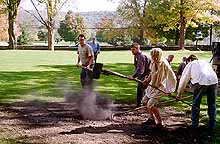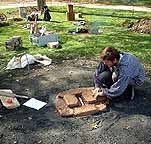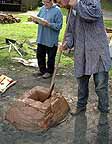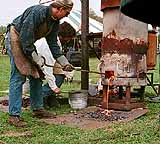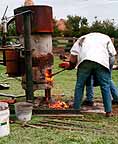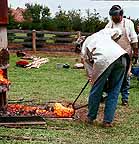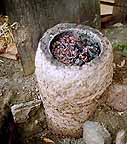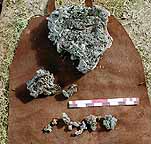Early Iron Symposium - 2004
the Farmer's Museum - Cooperstown NY
October 8-10, 2004
The first Early Iron Symposium was concieved and organized
by Michael McCarthy. The event was hosted at the
Farmer's Museum at Cooperstown New York in the historic Finger Lakes region.
The second weekend in October is a dual holiday - Columbus Day in the USA and
Thanksgiving in Canada, so the date and weather proved ideal. Roughly 90 participants
took part in the three day event. For the first Symposium, the stress was on
physical demonstrations. Three separate smelts were undertaken, one in each
of three different cultural tradtions. The event also included lectures on a
number of related topics, as well as several large discussion groups.
Japanese Tatara
This demonstration of the Japanese Tatara iron smelting tradition was undertaken
by Michael McCarthy of the Farmer's Museum (at Cooperstown NY). He had
recently attended a workshop under the instruction of Kihara - one of the 'Living
Treasures' of Japan.
The preparation of the tatara takes several days, primarily in the heating
and compacting of the base soil. A tall split wood fire is burned out, then
the remaining ash and charcoal are compacted. Once the base is judged suitable,
then the large structure of clay blocks is built up. This structure is then
pre fired (itself a day long process).
Once dried and heated, the smelter is filled with charcoal and fired. This
is a lengthy process - the smelt itself took about 12 plus hours. Ore used was
a fine hematite sand (from a local source Mike had discovered). The end result
was a bloom of about 20 lbs - with a medium to high carbon content.
The images here are from this preparation and construction phase.
|
|
|
|
Using a large fire of split wood to dry the earth
base. |
Compacting the still hot ash and earth using the
'Troll Hammer' |
Starting to lay up the structure using green clay
'bricks'. |
Mike used considerable car in constructing the
tatara. |
'Electro-Roman' Smelter
Lee Sauder and Skip Williams of Rockbridge Bloomery (Lexington
VA) use a process based on historic practice modified with modern equipment
to create a dependable process. This specific smelt was about the 45th they
had undertaken - using a method that predicably creates a good bloom every time.
The size and layout is based on late Roman Age smelters. The scale here is reasonably
large, with each smelt requiring about 250 lbs of charcoal and 100 lbs of roasted
ore. Ore used is a rock ore gathered from an abandoned Colonial Era open cut
mine close to Lexington. Results are typically a bloom in the 25 - 30 lb range.
At the Early Iron 1, the term 'Electro Roman' was coined to describe this system.
In October of 2002, the Frontier Culture Museum at Staunton Virginia, hosted
a special program featuring a demonstration by Lee and Skip. The images seen
here are from that smelt.
|
|
|
|
A close up of the large 'African Queen' test smelter. |
Lee tapping off slag. |
Clearing charcoal and loosening the slag bowl. |
Extracting the hot bloom from the bottom of the furnace. |
Norse 'Short Shaft'
The last demonstration of the Symposuim was undertaken by Darrell Markewitz
of the Wareham Forge (Ontario Canada). Not part of the original schedule, this
smelt allowed a group of the participants to get directly involved with building
and firing the smelter. Darrell has been involved in work for Parks Canada at
the Viking Age site at L'Anse aux Meadows Newfoundland. One important feature
of that archaeological site is that it contains the remains of the first iron
smelter ever used in North America, circa 1000 AD.
The smelter constructed at Early Iron 1 was closely based on those used during
the Viking Age. Another important feature was the use of a re-constructed Norse
double chamber bellows for the air supply. Athough the final result was closer
to a 'pre bloom mass' than a compact iron bloom - it was the first time this
historic method had been undertaken in North America in 1000 years!
|
|
|
|
Participants packing clay cobb mix into sheet metal
forms to create the smelter. |
Using the Norse double bellows. One stroke every 5
seconds for over four hours! |
Showing an ore charge added to the top of the burning
column of charcoal. |
The final 'pre bloom mass' which when latter sectioned
showed bubbles of iron within it. |
For measured drawings and the notes taken during the course of the experiment
- go HERE
Text and Images ©
2005 - 2007 Darrell Markewitz - the Wareham Forge

